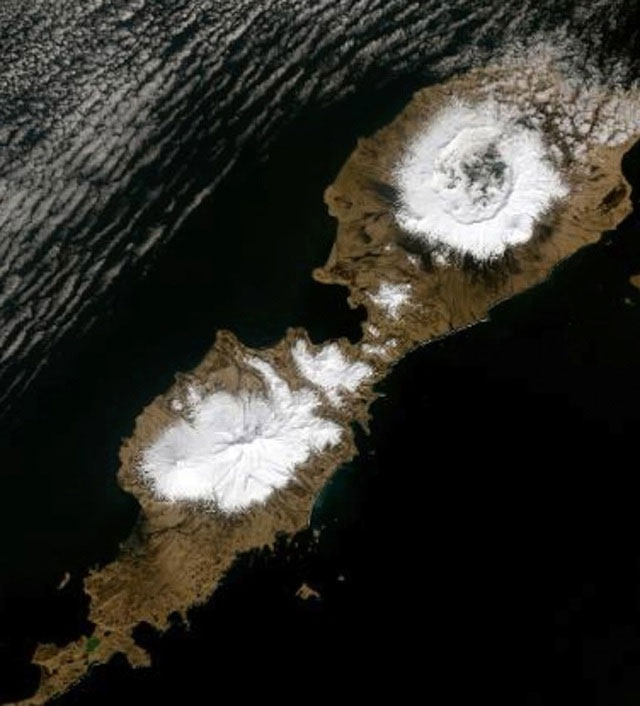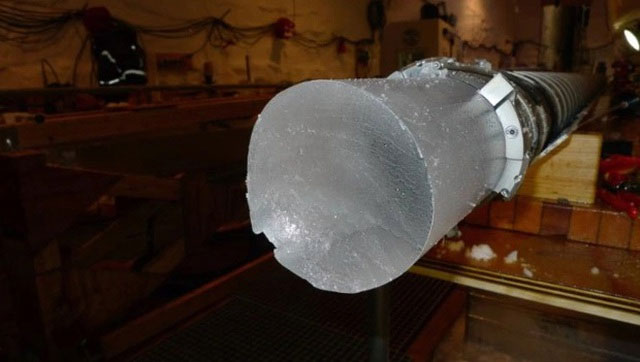What caused the ancient Roman republic to collapse?
Scientists believe that the volcanic eruption 2,500 years ago caused a global climate disaster that led to widespread famine in 43 BC.

Scientists believe that an ancient volcanic eruption has been identified.
The Okmok volcano event on an island in Alaska erupted in 43 BC is known by scholars as 'Okmok II'. This disaster caused the ashes to cover the sky, sunlight not shining on the ground and everything becoming cold. According to scientists, that's why the Mediterranean spent the summer of that year in the coldest of the last two millennia.
This happened at the same time as the Roman leader Julius Caesar was assassinated in 44 BC. The ancient texts mentioning this period all mention unusually cold weather, crop failure, famine, disease and instability.

Research and understand samples taken from ice cores.
Today, researchers claim that all of these factors led to the collapse of the Roman Republic. They rely on studies of old volcanic ash, also known as volcanic ash , found in ice cores in the Arctic.
Co-author of the study, Dr. Gill Plunkett, an archaeologist at Queen's University of Belsfast, Ireland, said the team compared the chemical traces of volcanic debris found in ice with mites. The debris from the volcanoes is said to have erupted at that time and it is clear that the debris in the ice is the ash of Okmok II.
The erupting Okmok volcano was not the only bad thing that happened to the Roman Republic then. The murder of Julius Caesar also led to the confusion of power struggle and eventually the Roman Empire formed and conquered the world.
One of the fundamental differences between these two political systems is that the Roman Republic was led by elected individuals while the Roman Empire was ruled by 'dictators' . The Roman Empire continued to become one of the most powerful states the world had ever witnessed.
Historians have long suspected that volcanic eruptions were the cause of the ice age mentioned in ancient texts, but they have no evidence, until today when Tien's research team Dr. Gill Plunkett gave results that justify it.

The volcanic explosion occurred just before the murder of Julius Caesar.
Last year, a team found a very well preserved ancient ice layer in the Arctic and decided to learn about it. They used analytical methods to identify two volcanic explosions, one of which was the Okmok II event .

The ice core contains ancient ash.
Then further analysis, such as the tree life cycle study, also confirmed the findings were accurate.
From this the researchers concluded that in the two years after the volcanic explosion, the ancients experienced summers and summers with temperatures about 7 ° C lower than normal. Besides, the climate is also extremely humid.
All of these factors are in line with other evidence of that historical period and even volcanic eruptions are associated with strange atmospheric phenomena. At the same time, the sky had 3 suns, the sun was dark and the halos of the sun were considered bad omens.
This new research explains these phenomena and helps us better understand the dark period in Roman history. The researchers published the results in the Proceedings of the National Academy of Sciences, UK.
- Discovered the unexpected cause of the collapse of the ancient Roman empire
- The secret of the ancient Roman people 's concrete
- Life of a citizen of the Roman Empire in ancient times: Every day must survive
- Discovering a huge ancient Roman theater in England
- Unexpected code decoding on New Year's Day
- Discover the 'whole vegetable' diet of ancient Roman gladiators
- Pharmacy in ancient Rome
- Confused about the sexual assault, the tyranny of Roman times
- Marvel at the tools that help reduce the damage of ancient Roman warriors
- Discover the ancient Roman military road
- The secret to survival in ancient Roman society is the thick side!
- The rare ancient Roman mosaic of the 4th century was discovered in England
 Discovered an ancient centipede fossil 99 million years old
Discovered an ancient centipede fossil 99 million years old Discovered bat-like dinosaurs in China
Discovered bat-like dinosaurs in China Discovered a 200-year-old bronze cannon of the coast
Discovered a 200-year-old bronze cannon of the coast Discover 305 million-year-old spider fossils
Discover 305 million-year-old spider fossils